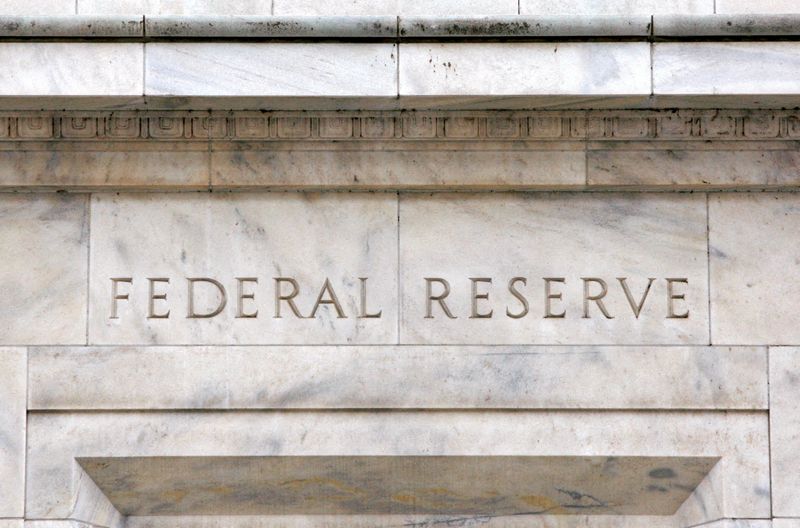By Michael S. Derby
NEW YORK (Reuters) – The Federal Reserve appears likely to take a step on Wednesday to nudge cash off its balance sheet as it enters a more uncertain period in what many see as the final months in its effort to draw down its balance sheet.
Economists broadly expect the Fed to announce it’s cutting the rate it pays money market funds and others to park cash at its overnight reverse repo facility, or ONRRP, by a bigger margin than the expected cut to its policy rate. While the federal funds rate target is seen being trimmed by a quarter-percentage-point to between 4.25% and 4.50%, the reverse repo rate, or RRP, is seen falling to 4.25% from its current setting of 4.55%.
The Fed has adjusted the rate differential between fed funds and ONRRP previously, but those changes were aimed at keeping the funds rate in the desired range or navigating periods of near-zero rates. Harmonizing the spread now, Fed watchers reckon, could help the central bank gain some flexibility as it sheds bond holdings, referred to as quantitative tightening, or QT.
“It makes sense to me that at some point the [Federal Open Market] Committee would want to return the overnight RRP offer rate to the bottom of the target range,” said Patricia Zobel, former manager of the New York Fed team that implements monetary policy and now head of macroeconomic research and market strategy at Guggenheim Investments.
Changing the rate “will be effective at encouraging people to find alternatives” to parking money at the Fed and it will likely lower money market rates as well, she said.
The Fed’s reverse repo rate is designed to set a soft floor for short-term interest rates. Along with the rate paid to deposit-taking banks for reserves, it helps keep the Fed’s policy rate within its targeted range.
From near zero usage in spring of 2021 to a peak of $2.6 trillion at the end of 2022, the reverse repo facility, which takes in cash primarily from money market funds, has contracted as the Fed has shrunk its balance sheet from a record $9 trillion in the summer of 2022 to $7 trillion by allowing some of its Treasury and mortgage-backed securities holdings to expire and not be replaced. For months, though, ONRRP totals have been range-bound and have yet to slide below $100 billion.
Fed officials who have weighed in on the matter have indicated they’d like to see ONRRP move back to negligible levels, and that doing so is important for QT. Draining the Fed facility will mean excess liquidity has largely been removed and allow bank reserves to finally start falling, ultimately allowing QT to stop.
Active usage of the ONRRP facility “was always something that was meant to be temporary,” said Derek Tang, an analyst at LH Meyer. But “temporary has lasted for a long time.”
The facility has made the Fed “a provider of safe assets to the money fund industry,” he said, but that was never the Fed’s intention, and it appears the central bank wants to close that chapter.
STICKY MONEY
Still, observers note making it less attractive to park cash at the Fed may not be enough: Some of the money funds are large enough to have challenges placing cash elsewhere.
“Part of the reason the RRP facility has been so sticky is that some money funds use RRP as a source of liquidity because of the ease of scaling in and out of the facility on a daily basis – especially late in the day if they have late-day inflows,” said Gennadiy Goldberg, head of U.S. rates strategy at TD Securities. “I think lowering the RRP rate will increase the opportunity cost of keeping cash in the RRP facility but may only marginally decrease the remaining cash in the facility.”
The Fed itself also sees possible challenges to getting cash out of ONRRP and QT’s end, given the potential for a reintroduction of the government debt ceiling next year. Possible “substantial shifts” in government cash management “could mask the effects of ongoing balance sheet runoff on money market conditions and pose challenges in assessing reserve conditions,” according to the meeting minutes from the Fed’s November meeting.
Banks surveyed by the New York Fed ahead of the Fed’s November policy meeting expected QT to end in May and the Fed then to keep its balance sheet steady at around $6.4 trillion.

While the November meeting minutes suggest to many a strong chance of an ONRRP rate tweak on Wednesday, analysts at Wrightson ICAP (LON:NXGN) think the Fed will hold off until January and move the rate down at a meeting when the fed funds rate is left unchanged, as rate futures markets currently expect.
Whatever happens on Wednesday, the weeks ahead will be unsettled for money markets, adding to the difficulty in predicting an end to QT. Quarter-end volatility has been rising with broad expectations that ONRRP will see a year-end spike, while cash is also expected to go to the Fed’s standing repo facility, or SRF (NS:SRFL). But even that is widely expected to be just a bump in the road with no greater bearing on the QT endgame.



